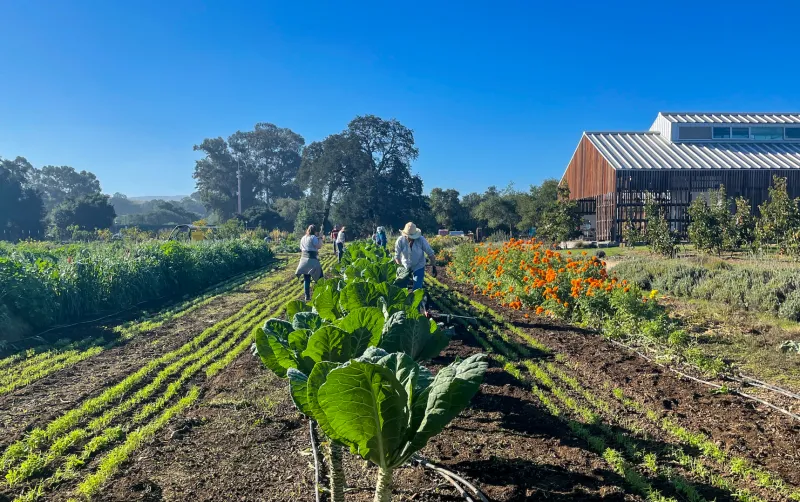Patrick Archie walked through the vibrant fields of Stanford’s O’Donahue Educational Farm, stopping every few yards to admire and describe the budding produce. Archie, who is particularly interested in sustainable agriculture, has been in his role as the Farm’s director for about 10 years.
Under Archie’s leadership, the Farm offers hands-on opportunities for community members to practice sustainable agriculture and serves as a natural haven for the greater Stanford community. From welcoming volunteers on Saturday and Wednesday mornings to employing students as farmhands and hosting Earthtones, an annual environmental justice festival, the farm is a place where Stanford students can develop an understanding and appreciation for the land on which they live.
The Farm, which is located at Governor’s Corner, was established by the School of Earth, Energy and Environmental Sciences in 2014, after more than two decades of advocacy led by students in the Earth Systems department. Like all of Stanford’s campus, the farm sits on the ancestral land of the Muwekma Ohlone people.
Archie explained how the Farm utilizes agro-ecological relationships and natural diversity to grow over 200 varieties of vegetables, flowers, herbs, field crops and fruit. He said that part of the Farm’s mission is to challenge the traditions of the agriculture industry, which tends to prioritize “amassing wealth and extracting” from the land.
“Those of us that study agroecology are really interested in the Indigenous roots of agriculture, an agriculture that is designed to fit in the ecosystem that it’s in. It’s designed to support the community,” Archie said. Agroecology is the study of agricultural practices that work with the natural environment, rather than impose unsustainable or foreign farming practices on it. Archie said that agroecology supports farming that is “not designed necessary just to extract and sell to distant markets.” Rather, he said, the Farm’s fundamental goal is to “nourish its community.”
The Farm annually harvests over 15,000 pounds of produce, which is then sold to campus dining as well as local chefs and caterers. The Farm also produces thousands of flowers, which are cut, arranged and sold as bouquets, generating additional revenue opportunities to support student employment at the Farm.
“The other thing about the flowers is they’re often in different crop families from our other crops so the flowers help us with our crop rotations,” Archie said. “We try to manage the soil to make it really biologically rich, diverse, and healthy. One of the ways that we break pest and disease cycles is by rotating crops.”
Environmental justice makes up another key component of the Farm’s mission.
Archie used the phrase “liberation through land” to capture the intersection between agriculture and Indigenous rights advocacy. The Farm partners with Native Seed Search, an organization that collects ancient crop varieties to create a drought-resistant living seed bank. The Farm is currently growing a crop of Dene corn to contribute to the seed bank.
Earthtones — originally named Earth in Color — is an environmental justice festival led by Natalie Cross ’22 that is hosted at the Farm each year. The festival reimagines Earth Day to celebrate and center the narratives of students of color in the context of environmentalism. During the pandemic Earthtones organizers produced a collection of student art and writing in lieu of holding in-person events. Community members will celebrate Earthtones in person again this spring.
Cross began working as a farmhand during her sophomore year and has stayed in the role ever since.
“I love being able to dig in the dirt for a few hours. The Farm is great for keeping up with this crazy school where so many things are happening all the time,” Cross said. “The Farm has been a really special place for me and my happy little home away from craziness.”
The student organization Stanford Roots helps out with harvests and hosts events like pizza night and the Fall Harvest Festival on the farm grounds.
Stanford Roots co-leader Diego Rafael Pérez ’23 started volunteering on the Farm when he was a frosh.
“I thought it was a great practice to do in the mornings before classes to really reground and center myself and remember why I’m here and what I’m working for,” Pérez said.
Archie, Cross and Pérez all emphasized that the Farm is a space that is open to everyone and intended to give community members the opportunity to connect with nature and find a moment to breathe amid the chaos of campus life.
“Everyone is welcome to the Farm,” Archie said. “This farm is shared by everyone. Please come enjoy it. There’s ways for everybody to plug in whether you’re a student or staff or faculty member or community member.”
